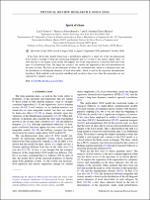Please use this identifier to cite or link to this item:
https://hdl.handle.net/20.500.12202/6434Full metadata record
| DC Field | Value | Language |
|---|---|---|
| dc.contributor.author | Santos, Lea F. | |
| dc.contributor.author | Pérez-Bernal, F. | |
| dc.contributor.author | Torres-Herrera, E.J. | |
| dc.date.accessioned | 2020-11-18T19:11:01Z | |
| dc.date.available | 2020-11-18T19:11:01Z | |
| dc.date.issued | 2020 | |
| dc.identifier.citation | LF Santos, F Pérez-Bernal, EJ Torres-Herrera. Spech of Chaos. (2020). Physical Review Research 2 (4), 043034 | en_US |
| dc.identifier.issn | 1550-2376 | |
| dc.identifier.uri | https://doi.org/10.1103/PhysRevResearch.2.043034 | en_US |
| dc.identifier.uri | https://hdl.handle.net/20.500.12202/6434 | |
| dc.description | Research article, peer-reviewed. Open -Access. | en_US |
| dc.description.abstract | It has been shown that, despite being local, a perturbation applied to a single site of the one-dimensional XXZ model is enough to bring this interacting integrable spin-1/2 system to the chaotic regime. Here, we show that this is not unique to this model, but happens also to the Ising model in a transverse field and to the spin-1 Lai-Sutherland chain. The larger the system is, the smaller the amplitude of the local perturbation for the onset of chaos. We focus on two indicators of chaos, the correlation hole, which is a dynamical tool, and the distribution of off-diagonal elements of local observables, which is used in the eigenstate thermalization hypothesis. Both methods avoid spectrum unfolding and can detect chaos even when the eigenvalues are not separated by symmetry sectors. | en_US |
| dc.description.sponsorship | L.F.S. was supported by the NSF Grant no. DMR-1936006 and thanks Angela Foerster for discussions. This work has received funding from the Spanish National Research, Development, and Innovation plan (RDI plan) under Project No. PID2019-104002GB-C21. It has been partially supported by the Consejería de Conocimiento, Investigación y Universidad, Junta de Andalucía and European Regional Development Fund (ERDF), ref. nos. SOMM17/6105/UGR and UHU-1262561. Computing resources were provided by the CEAFMC and Universidad de Huelva High Performance Computer (HPC@UHU) located in the Campus Universitario el Carmen and funded by FEDER/MINECO project UNHU- 15CE-2848. E.J.T.-H. was funded from VIEP-BUAP (Grants No. MEBJ-EXC19-G, No. LUAGEXC19-G), Mexico. He is also grateful to LNS-BUAP for their supercomputing facility. | en_US |
| dc.language.iso | en_US | en_US |
| dc.publisher | American Physical Society | |
| dc.relation.ispartofseries | Physical Review Research;2 (4) | |
| dc.rights | Attribution-NonCommercial-NoDerivs 3.0 United States | * |
| dc.rights.uri | http://creativecommons.org/licenses/by-nc-nd/3.0/us/ | * |
| dc.subject | chaos | en_US |
| dc.subject | indicators | en_US |
| dc.subject | correlation hole | en_US |
| dc.subject | chaos detection | en_US |
| dc.subject | off-diagonal elements | en_US |
| dc.title | Speck of chaos. | en_US |
| dc.type | Article | en_US |
| dc.contributor.orcid | 0000-0001-9400-2709 | |
| local.yu.facultypage | https://www.yu.edu/faculty/pages/santos-lea | |
| Appears in Collections: | Stern College for Women -- Faculty Publications | |
Files in This Item:
| File | Description | Size | Format | |
|---|---|---|---|---|
| Speck 2020 PhysRevResearch.2.043034.pdf | 1.04 MB | Adobe PDF |  View/Open |
This item is licensed under a Creative Commons License

